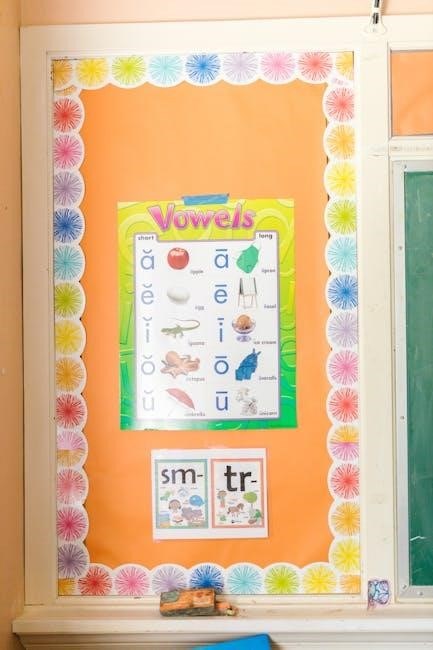Heating, Ventilation, and Air Conditioning (HVAC) systems are essential for maintaining indoor comfort and air quality. They regulate temperature, humidity, and airflow in residential, commercial, and industrial spaces, ensuring energy-efficient climate control.
1.1 What is HVAC?
HVAC stands for Heating, Ventilation, and Air Conditioning. It refers to systems that regulate indoor air quality, temperature, and humidity for comfort and health. These systems provide heating through furnaces or heat pumps, ventilation through airflow management, and cooling via refrigeration. Essential in homes, offices, and industries, modern HVAC systems emphasize energy efficiency and sustainability.
1.2 Importance of HVAC Systems
HVAC systems are crucial for maintaining indoor air quality, thermal comfort, and humidity levels. They ensure a healthy environment by controlling airborne pathogens and pollutants. In commercial settings, HVAC systems enhance productivity and employee well-being. Residentially, they provide comfort and safety during extreme weather. Properly functioning HVAC systems also reduce energy consumption, contributing to environmental sustainability and cost savings.
1.3 Brief History of HVAC Development
The origins of HVAC systems trace back to the early 19th century with advancements in steam heating. The 20th century saw the invention of modern air conditioning by Willis Carrier in 1902, revolutionizing indoor climate control. Over time, technologies evolved to improve efficiency, safety, and environmental compatibility, leading to the sophisticated HVAC systems we rely on today.

Key Components of HVAC Systems
HVAC systems consist of heating, ventilation, and air conditioning units. Key components include furnaces, heat pumps, air conditioning units, ductwork, vents, thermostats, and air filters.
2.1 Heating Systems
Heating systems are designed to warm indoor spaces, ensuring comfort during colder months. They include furnaces, boilers, heat pumps, and radiant floor systems, using fuels like natural gas, electricity, or propane. These systems distribute heat via ducts or radiators, maintaining consistent temperatures while improving energy efficiency and reducing operational costs.
2.2 Cooling Systems
Cooling systems are designed to remove heat and moisture from indoor spaces, providing a comfortable environment. They include air conditioners, evaporative coolers, and chillers, which use refrigeration cycles to transfer heat outside. These systems often incorporate fans, coils, and compressors to circulate cooled air. Proper installation and maintenance ensure efficient operation, reducing energy consumption and enhancing indoor air quality in both residential and commercial settings.
2.3 Ventilation Systems
Ventilation systems are crucial for maintaining indoor air quality by exchanging stale air with fresh outdoor air. They enhance oxygen levels, remove pollutants, and regulate humidity. Components include ducts, fans, and vents, ensuring proper airflow. Natural ventilation uses windows and vents, while mechanical systems employ fans and blowers for forced air circulation. Proper ventilation is essential for health, comfort, and energy efficiency in all building types.

HVAC Fundamentals
HVAC systems operate on principles of heat transfer, thermodynamics, and air quality management. Understanding these fundamentals is key to designing and maintaining efficient heating, cooling, and ventilation systems.
3.1 Heat Transfer Principles
Heat transfer is the movement of thermal energy from one point to another, occurring through conduction, convection, or radiation. In HVAC, conduction involves direct contact between materials, while convection relies on fluid movement. Radiation transfers heat via electromagnetic waves. Understanding these principles is crucial for designing systems that efficiently heat, cool, and ventilate spaces. This knowledge ensures optimal energy use and system performance.
3.2 Thermodynamics Basics
Thermodynamics governs the relationships between heat, work, and energy. The first law states energy is conserved, while the second law introduces entropy, measuring disorder. In HVAC, these principles guide heat transfer, energy conversion, and system efficiency. Understanding thermodynamics is vital for designing systems that effectively balance energy use and environmental impact, ensuring optimal performance and comfort in various applications.
3.3 Air Quality and Filtration
Air quality is crucial for indoor comfort and health. HVAC systems use filters to remove pollutants like dust, allergens, and bacteria, improving air purity. Proper filtration enhances respiratory health and reduces contamination. High-efficiency filters, such as HEPA, capture 99.97% of particles as small as 0.3 microns, ensuring cleaner air. Regular maintenance of filters is essential to maintain airflow and system efficiency, promoting a healthier indoor environment.

Choosing the Right HVAC System
Selecting the right HVAC system involves considering space size, budget, and efficiency needs. Evaluate system types and energy ratings to ensure optimal performance and long-term savings.
4.1 Factors to Consider
When selecting an HVAC system, consider space size, budget, and energy efficiency. Climate, insulation, and existing ductwork also play a role. Evaluate system types, such as central, ductless, or heat pumps, and their compatibility with your needs. Load calculations and professional installation are crucial for optimal performance and long-term savings. Ensure the system meets local building codes and energy standards for reliability and efficiency.
4.2 Types of HVAC Systems
Common HVAC systems include central air systems, ductless mini-splits, heat pumps, and packaged units. Each offers unique benefits, such as energy efficiency, space-saving design, or cost-effectiveness. Central systems are ideal for large spaces, while ductless systems suit smaller areas. Heat pumps provide both heating and cooling, making them versatile. Packaged units combine all components into one, simplifying installation and maintenance for various applications.
4.3 System Sizing and Load Calculation
Proper HVAC system sizing and load calculation ensure optimal performance and efficiency. This involves assessing space requirements, insulation, windows, and occupancy. Tools like Manual J help determine heating and cooling loads. Accurate calculations prevent oversizing or undersizing, ensuring systems meet demands without energy waste. This step is crucial for balancing comfort, energy efficiency, and system longevity in various environments.

Installation and Maintenance
Proper installation ensures HVAC systems operate efficiently, while regular maintenance extends lifespan and prevents breakdowns. Neglecting these steps can lead to reduced performance and higher energy costs.
5.1 Installation Best Practices
Proper installation is critical for HVAC efficiency and performance. Ensure all components are sized correctly and installed per manufacturer guidelines. Secure ductwork tightly to prevent leaks, and ensure proper refrigerant charging. Regularly inspect and test the system post-installation to guarantee optimal operation. Hiring certified technicians ensures compliance with safety standards and industry best practices for a reliable setup.
5.2 Regular Maintenance Requirements
Regular HVAC maintenance ensures system longevity and efficiency. Replace air filters monthly to improve airflow and reduce energy costs. Clean condenser coils annually to prevent overheating. Inspect ducts for leaks and seal them to maintain proper air pressure. Schedule professional tune-ups twice a year to check refrigerant levels and electrical connections, ensuring optimal performance and preventing costly repairs.
5.3 Troubleshooting Common Issues
Common HVAC issues include insufficient heating or cooling, unusual noises, and system shutdowns. Check thermostat settings and power sources first. Leaks in refrigerant lines or ducts can cause poor performance. Clogged air filters may reduce airflow. For electrical or complex mechanical problems, contact a licensed technician to avoid further damage and ensure safe repairs, maintaining system efficiency and reliability.

Safety in HVAC Operations
Safety in HVAC operations involves handling refrigerants safely, following electrical precautions, and ensuring proper ventilation to maintain indoor air quality and prevent hazardous conditions during system maintenance.
6.1 Handling Refrigerants Safely
Handling refrigerants safely is crucial to prevent environmental harm and personal injury. Always use approved equipment and follow proper procedures when charging, recovering, or disposing of refrigerants. Ensure compliance with regulations like the Clean Air Act to minimize ozone depletion and climate impact. Proper training and certification are essential for technicians to handle refrigerants responsibly.
6.2 Electrical Safety Precautions
Electrical safety is critical when working with HVAC systems. Always disconnect power before servicing equipment and verify voltage with a multimeter. Use appropriate personal protective equipment, such as insulated gloves and safety glasses. Ensure all tools are properly rated for the voltage levels involved. Never bypass safety devices, and strictly adhere to NFPA 70 (NEC) guidelines to prevent shocks, arcs, or fires;
6.3 Indoor Air Quality Concerns
Indoor air quality (IAQ) is vital for occupant health and comfort. HVAC systems must effectively filter pollutants, control humidity, and ventilate spaces to prevent mold growth and airborne contaminants. Proper system maintenance, including regular filter replacement and duct cleaning, ensures clean air circulation. Poor IAQ can lead to respiratory issues and health risks, emphasizing the importance of a well-designed and maintained HVAC system.

Energy Efficiency in HVAC
Optimizing HVAC energy efficiency reduces consumption and lowers operational costs. High-efficiency systems, smart thermostats, and regular maintenance ensure optimal performance while minimizing environmental impact and energy waste.
7.1 Improving System Efficiency
Enhancing HVAC system efficiency involves upgrading to high-efficiency equipment, ensuring proper installation, and maintaining regular maintenance. Smart thermostats and programmable controls optimize temperature settings, reducing energy waste. Additionally, sealing duct leaks and improving insulation can significantly improve system performance, leading to lower energy bills and a reduced environmental footprint while maintaining indoor comfort and air quality.
7.2 Understanding SEER and AFUE Ratings
SEER (Seasonal Energy Efficiency Ratio) measures cooling system efficiency, while AFUE (Annual Fuel Utilization Efficiency) rates heating systems. Higher SEER and AFUE values indicate better energy performance. SEER is calculated over a cooling season, and AFUE reflects annual efficiency. Both ratings help consumers evaluate system performance and energy savings, guiding informed decisions for optimal HVAC system selection and energy efficiency.
7.3 Smart Thermostats and Energy Management
Smart thermostats optimize heating and cooling by learning usage patterns and adjusting settings automatically. They offer remote access via mobile apps, voice control, and energy usage tracking. These devices improve energy efficiency, reduce costs, and enhance comfort. Smart thermostats also integrate with smart home systems, enabling seamless energy management and contributing to overall HVAC system performance and sustainability.

Career Opportunities in HVAC
HVAC offers diverse career paths, including technicians, engineers, and system designers. These roles are in high demand, ensuring job stability and opportunities for professional growth and specialization.
8.1 Job Roles in the HVAC Industry
The HVAC industry offers various roles, including HVAC technicians, installers, engineers, and sales specialists. Technicians diagnose and repair systems, while engineers design and optimize HVAC solutions. Installers focus on system setup, and sales specialists assist clients in selecting appropriate equipment. Each role requires specific skills, from hands-on technical expertise to strong customer service abilities, ensuring a dynamic career path with opportunities for advancement.
8.2 Certifications and Training Programs
Certifications like NATE and EPA Section 608 are crucial for HVAC professionals, ensuring compliance with industry standards. Training programs, such as those offered by trade schools or manufacturers, provide hands-on experience in system installation, maintenance, and troubleshooting. These programs often cover safety protocols, energy efficiency, and refrigerant handling, preparing technicians for real-world challenges and enhancing their career prospects in the industry.
8.3 Salary Expectations and Growth Prospects
HVAC technicians can expect competitive salaries, with entry-level positions starting around $40,000 annually. Experienced professionals may earn upwards of $80,000 or more, depending on location and specialization. The industry is projected to grow steadily, driven by increasing demand for energy-efficient systems and regulations on refrigerants, offering promising career advancement opportunities.

Exam Preparation and Resources
Effective study strategies and practice tests are crucial for HVAC exam success. Utilize sample questions and recommended study guides to ensure comprehensive preparation and optimal results.
9.1 Study Strategies for HVAC Exams
To excel in HVAC exams, focus on understanding key concepts like heat transfer and thermodynamics. Use practice tests to identify weaknesses and review study guides thoroughly. Prioritize topics with higher weightage and allocate time effectively for each section. Regularly test your knowledge and stay organized to ensure comprehensive preparation and achieve optimal results.
9.2 Sample Questions and Practice Tests
Utilizing sample questions and practice tests is crucial for HVAC exam preparation. These resources help identify knowledge gaps and familiarize you with the exam format. Focus on solving problems related to system design, troubleshooting, and safety protocols. Regularly reviewing practice tests enhances problem-solving skills and builds confidence, ensuring readiness for the actual exam.
9.3 Recommended Study Materials and Guides
For effective HVAC study, utilize textbooks, online courses, and industry guides. Resources like “HVAC Fundamentals” and “Refrigeration and Air Conditioning” provide foundational knowledge. Online platforms offer interactive tutorials and simulations. Additionally, tools such as psychrometric charts and load calculation software are invaluable. Always opt for updated materials to align with current standards and practices, ensuring comprehensive understanding and practical application of HVAC principles.
Mastery of HVAC principles ensures efficient climate control, enhancing comfort and sustainability. Continuous learning and adaptation to new technologies are vital for success in this evolving field.
10.1 Summary of Key Concepts
HVAC systems regulate temperature, humidity, and airflow, ensuring comfort and energy efficiency. Key concepts include heat transfer, thermodynamics, system components, and maintenance. Understanding these principles is crucial for effective installation, operation, and troubleshooting. Additionally, energy efficiency and safety protocols are vital for optimal performance and environmental sustainability in modern HVAC practices.
10.2 Final Tips for Success in HVAC
Stay updated with industry advancements and certifications. Prioritize hands-on training and practical experience. Develop strong problem-solving and communication skills. Always follow safety protocols and best practices. Build a network of professionals for support and opportunities. Lastly, embrace continuous learning to adapt to new technologies and challenges in the HVAC field.







